SUBFAMILY MYRMICINAE - Genus Myrmicaria - key to workers
| The Ants of
Africa SUBFAMILY MYRMICINAE - Genus Myrmicaria - key to workers |
|
| Contents - Myrmicinae - Genus Myrmicaria Introduction |
The following key to the Myrmicaria of Africa is translated
and quite extensively adapted by me from that of Santschi (1925c: 133),
plus later described species. The latter includes my separation of congolensis
to full species and removal of it and its subspecies from opaciventris.
Santschi's key was described by Bolton (1995) as "out of date" but
there is no more modern revision of the Genus. Using Santschi's and
other illustrations, I have also designed the key to be both textual
and visual.
I have not taken the separations beyond the level of species, i.e. I
have not included Santschi's separations of "subspecies". Where
appropriate, I have noted the variations in the main species sections.
| -- | Male only known (description unavailable) | Ethiopia - tigreensis |
| 1 |  TL 3.3-4.3 mm. Funiculus segments slender except for the
last which is a distinct large club. Petiole node much longer than
wide. Thoracic rugae mostly longitudinal, medially commonly faint.
Lower angles of pronotum (mesokatepisternal tooth) rounded. TL 3.3-4.3 mm. Funiculus segments slender except for the
last which is a distinct large club. Petiole node much longer than
wide. Thoracic rugae mostly longitudinal, medially commonly faint.
Lower angles of pronotum (mesokatepisternal tooth) rounded. 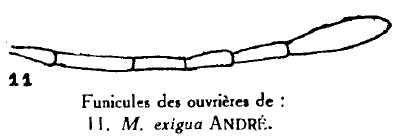 |
. |
| . |  |
West Africa & Congo Basin (arboreal) - exigua |
| -- | Otherwise and with a three-segmented antennal club. | 2 |
| 2 | Pedicel with low nodes which are longer than they are high | 3 |
| -- | Pedicel with high nodes which are higher than they are long | 4 |
| 2 | Pedicel with low nodes which are longer than they are high | 3 |
| 3 | 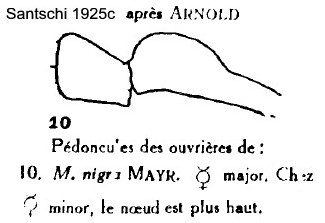 Brown-black;
TL 5.5 mm; petiole node longer than high or wide; node rounded and
compressed; Brown-black;
TL 5.5 mm; petiole node longer than high or wide; node rounded and
compressed; |
. |
| . |  |
South Africa - nigra |
| -- | 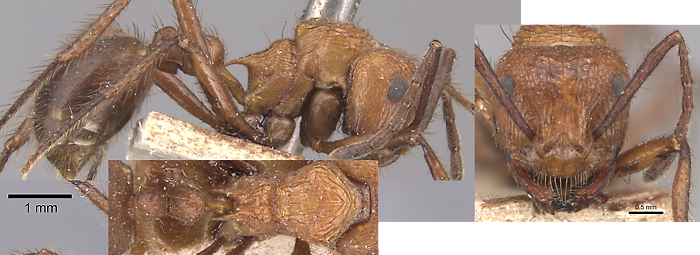 Dull
(dirty) ferruginous; antennae, pedicel and gaster fuscous, subopaque;
TL 6.0-6.5 mm; general body form like eumenoides; postpetiole
with distinct
ventral angular anterior process; clypeus carinate; scapes striated;
head and alitrunk longitudinally rugose, vertex of head weakly
subreticulate; lateral pedicel finely rugose; postpetiole and basal
gaster subtly punctate, so that the latter appears matt; mostly
nitidous; Dull
(dirty) ferruginous; antennae, pedicel and gaster fuscous, subopaque;
TL 6.0-6.5 mm; general body form like eumenoides; postpetiole
with distinct
ventral angular anterior process; clypeus carinate; scapes striated;
head and alitrunk longitudinally rugose, vertex of head weakly
subreticulate; lateral pedicel finely rugose; postpetiole and basal
gaster subtly punctate, so that the latter appears matt; mostly
nitidous; |
widespread in wooded areas - opaciventris |
| . | Pedicel with high nodes which are higher than they are long | . |
| 4 | Pronotum with little sculpturation restricted to transverse rugae and with no median longitudinal ruga | 5 |
| -- | Pronotum with at least a median longitudinal ruga | 6 |
| 5 | 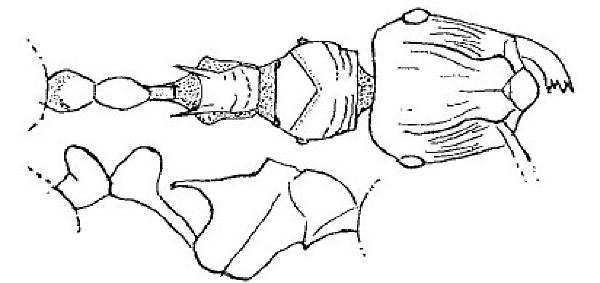 Brownish-black with sparse
whitish pilosity; TL 5.2 mm; pronotum dorsum with only partial
transverse rugae and straight anterior margin; petiole with high node; Brownish-black with sparse
whitish pilosity; TL 5.2 mm; pronotum dorsum with only partial
transverse rugae and straight anterior margin; petiole with high node; |
South Africa (high montane) - anomala |
| -- | 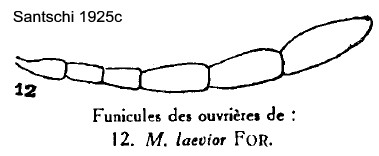 Yellow brown; erect pilosity yellowish; TL 3.9-4.2 mm;
petiole node wider than long; antennal segments very short Yellow brown; erect pilosity yellowish; TL 3.9-4.2 mm;
petiole node wider than long; antennal segments very short |
. |
| . | 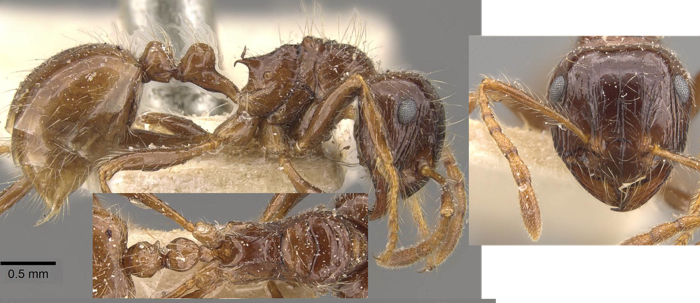 |
South Africa - laevior |
| . | Pronotum with at least a median longitudinal ruga | . |
| 6 | 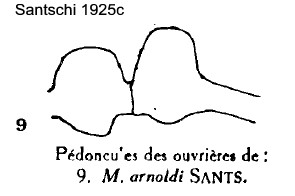 Postpetiole lower than petiole; red-brown; without a
promesonotal suture; TL 6.5-8.2 mm Postpetiole lower than petiole; red-brown; without a
promesonotal suture; TL 6.5-8.2 mm |
Zimbabwe - arnoldi |
| -- | Postpetiole at least as high as the petiole | 7 |
| 7 | Petiole profile near square with distinct vertical anterior and posterior faces plus a clearly separate dorsal face | 8 |
| -- | Petiole profile with distinctly sloping anterior and posterior faces plus a variably separate usually domed dorsal face | 9 |
| 8 |  Central area of head and
pronotum polished apart from the median carinae; clypeus without a
median carina; TL 4.3-5.5 mm; dark brown to near black Central area of head and
pronotum polished apart from the median carinae; clypeus without a
median carina; TL 4.3-5.5 mm; dark brown to near black |
. |
| . | 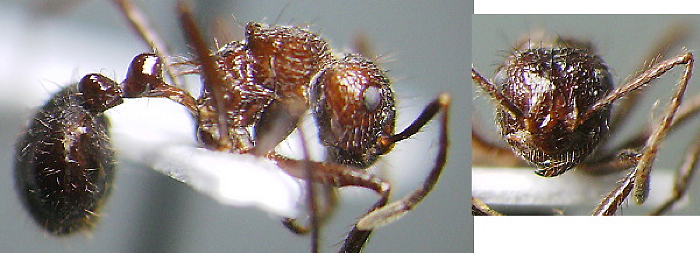 |
East Africa -
fusca
plus ssp consanguinea and nigerrima |
| -- | 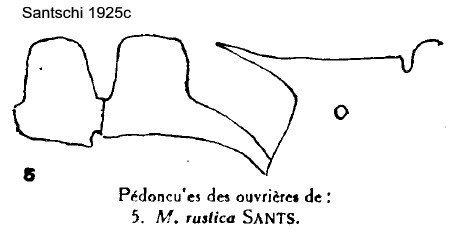 Dorsum
of propodeum with a strong transverse ridge; TL 7.5-8.0 mm; dark brown,
head and gaster brown black Dorsum
of propodeum with a strong transverse ridge; TL 7.5-8.0 mm; dark brown,
head and gaster brown black |
. |
| . | 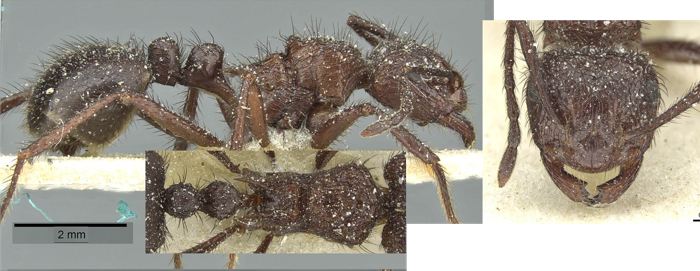 |
East Africa - rustica plus j syn angustior |
| . | Petiole profile with distinctly sloping anterior and posterior face plus a variably separate usually domed dorsal face | . |
| 9 |  Segment 3 of
the funiculus not or little longer than segment 2 Segment 3 of
the funiculus not or little longer than segment 2 |
9A |
| -- | Segment 2 of the
funiculus longer than segment 3  |
10 |
| 9A |  TL 5-0-6.8 mm;
alitrunk with
erect hairs short and sparse;
reddish yellow, with tarsi and gaster brown; striations on front of
head distinctly arcuate; clypeus longitudinally carinate and mandibles
striate; base of gaster slightly dull due to microspiculation TL 5-0-6.8 mm;
alitrunk with
erect hairs short and sparse;
reddish yellow, with tarsi and gaster brown; striations on front of
head distinctly arcuate; clypeus longitudinally carinate and mandibles
striate; base of gaster slightly dull due to microspiculation |
Senegal to
East Africa - distincta
plus ssp abyssinica and vorax |
| -- | 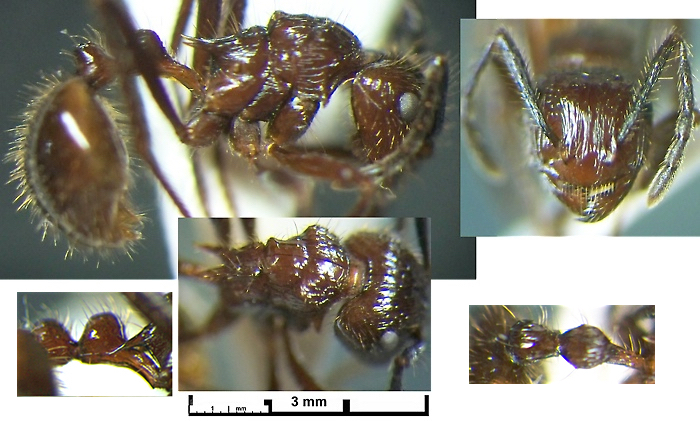 TL ca 8.0 mm; alitrunk
with abundant long erect hairs; striations
on front of head straight, clypeus and mandibles near smooth; seen from
above propodeal spines with only a small distance between the bases;
base of gaster wholly smooth and shiny TL ca 8.0 mm; alitrunk
with abundant long erect hairs; striations
on front of head straight, clypeus and mandibles near smooth; seen from
above propodeal spines with only a small distance between the bases;
base of gaster wholly smooth and shiny |
new species Senegal |
| 10 | 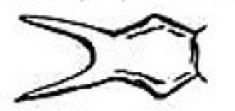 Funiculus
segment 3 twice as long as wide; thick-set; TL 4.5-5.5 mm; blackish
brown with upper head black, pedicel and base of gaster mid-brown, rest
of gaster yellowish brown Funiculus
segment 3 twice as long as wide; thick-set; TL 4.5-5.5 mm; blackish
brown with upper head black, pedicel and base of gaster mid-brown, rest
of gaster yellowish brown |
. |
| . |  pallida pallida |
South Africa
- foreli
plus j.syn. pallida |
| -- | Funiculus segment 3 more than twice as long as wide; generally larger | 11 |
| 11 |  Ventral surface of petiole
with two fine spines (not present on cotypes); TL 6-7 mm; clypeus
without a median carina; reddish brown; gaster brownish yellow; legs,
including the coxae and lower pleurae, darker than the thorax,
mandibular teeth and antennae blackish Ventral surface of petiole
with two fine spines (not present on cotypes); TL 6-7 mm; clypeus
without a median carina; reddish brown; gaster brownish yellow; legs,
including the coxae and lower pleurae, darker than the thorax,
mandibular teeth and antennae blackish |
. |
| . | 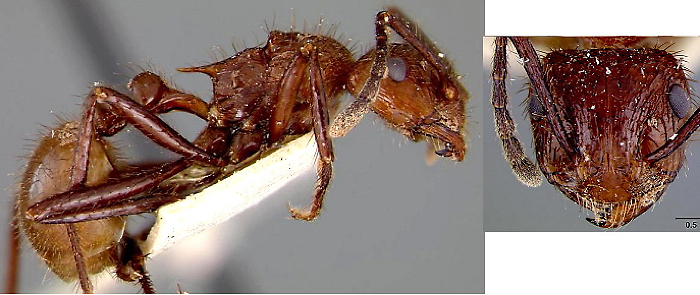 |
Zaïre - salambo |
| -- | Ventral surface of petiole without spines | 12 |
| 12 | 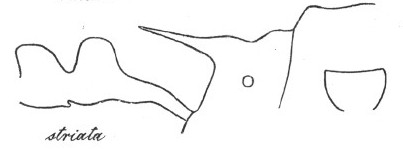 Mesokatepisternal
tooth (from base to apex) as long as the height of the pronotum (from
base of tooth to dorsum?);
blackish; TL 7.5-8 mm Mesokatepisternal
tooth (from base to apex) as long as the height of the pronotum (from
base of tooth to dorsum?);
blackish; TL 7.5-8 mm |
Katanga,
Zaïre - striata in part, ssp buttgenbachi |
| -- | Mesokatepisternal tooth less prominent | 13 |
| 13 | With abundant but very short erect hairs; head longitudinally striate without cross-meshes; petiole node conical, anterior face very oblique; TL 6.5-7.0 mm | Sâo Tomé I - striata
in part, ssp insularis |
| -- | Otherwise; from mainland Africa | 14 |
| 14 |  Anterior face of petiole node more vertical than
posterior, with the superior angle more acute than the anterior (basal)
angle Anterior face of petiole node more vertical than
posterior, with the superior angle more acute than the anterior (basal)
angle |
15 |
| -- | 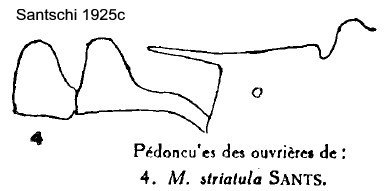 Petiole profile conical and more symmetric Petiole profile conical and more symmetric |
16 |
| 15 | 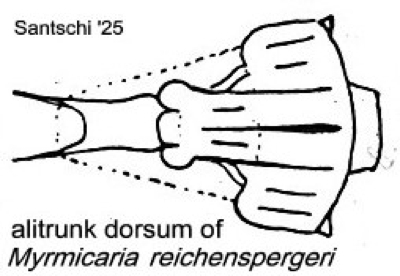 Pronotum
dorsum with all rugae straight and longitudinal,
median very elevated; pronotum with concave basal face; yellow-brown;
TL 6-6.5 mm Pronotum
dorsum with all rugae straight and longitudinal,
median very elevated; pronotum with concave basal face; yellow-brown;
TL 6-6.5 mm |
. |
| . |  |
Tanzania - reichenspergeri |
| -- | 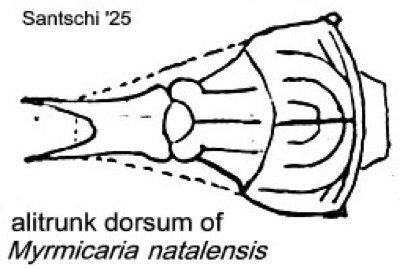 Pronotum dorsum
with rugae arched or transverse anterior
to the anastamose cup of pronotum; TL 5.5-7.0 mm; gaster smooth and
shiny; bright ferruginous,
antennae, legs and gaster much darker Pronotum dorsum
with rugae arched or transverse anterior
to the anastamose cup of pronotum; TL 5.5-7.0 mm; gaster smooth and
shiny; bright ferruginous,
antennae, legs and gaster much darker |
. |
| . | 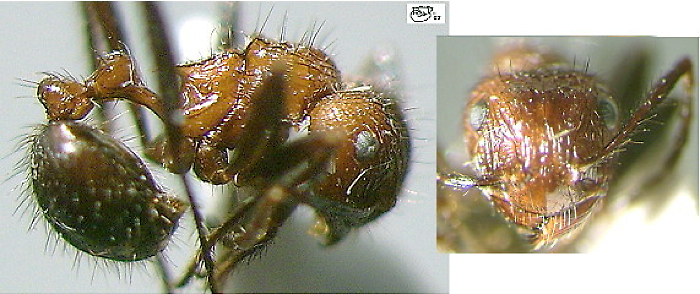 |
widespread savannah species - natalensis |
| 16 |  Colour dark red-brown, gaster black and wholly shiny; both
petiole and postpetiole nodes higher than long and in profile about
equal; dorsum of propodeum fairly concave forward; central area of head
largely smooth and shiny each side of the median ruga: TL 5.5-6.0 mm Colour dark red-brown, gaster black and wholly shiny; both
petiole and postpetiole nodes higher than long and in profile about
equal; dorsum of propodeum fairly concave forward; central area of head
largely smooth and shiny each side of the median ruga: TL 5.5-6.0 mm |
. |
| . | 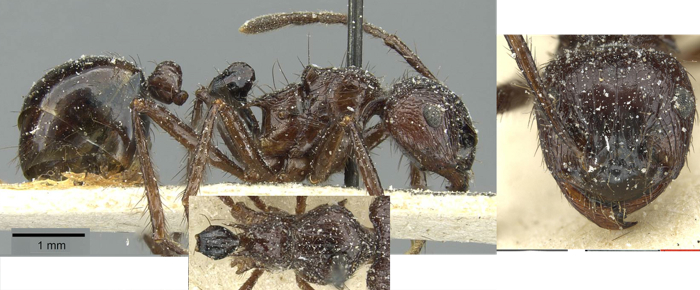 |
Tanzania, possibly only Kilimanjaro area; Congo Basin (?) - striatula |
| -- | 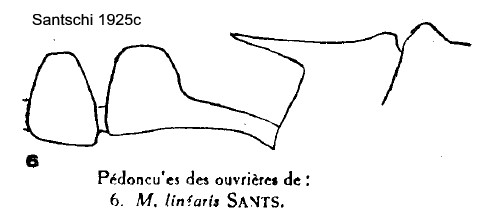 Otherwise (e.g. fumata linearis) Otherwise (e.g. fumata linearis) |
17 |
| 17 |  Pronotum rugae all
parallel Pronotum rugae all
parallel |
18 |
| -- |  Pronotum rugae
arched, transverse before meeting the
median ruga at a right angle (example congolensis) Pronotum rugae
arched, transverse before meeting the
median ruga at a right angle (example congolensis) |
21 |
| . | Pronotum rugae parallel | . |
| 18 | 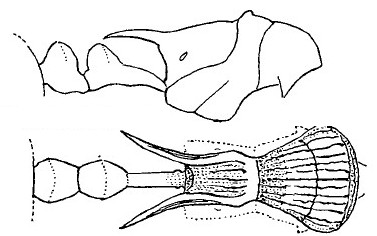 Propodeal
spines unusually long and downcurved; colour black, shiny; TL 6.5-6.7 mm Propodeal
spines unusually long and downcurved; colour black, shiny; TL 6.5-6.7 mm |
. |
| . | 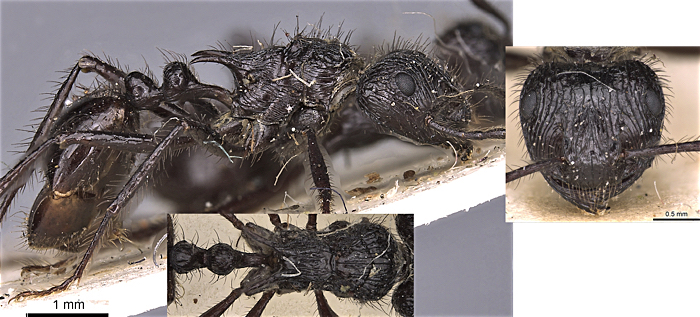 |
South Africa - faurei |
| -- | Propodeal spines more typical; pronotum with fainter and sparser rugae | 19 |
| 19 |  Pronotum dorsum with only 5
longitudinal rugae; colour pitch black and shiny; TL 5.6-6.0 mm Pronotum dorsum with only 5
longitudinal rugae; colour pitch black and shiny; TL 5.6-6.0 mm |
. |
| . |  . . |
Lesotho - basutorum |
| -- | Pronotum dorsum with more than five longitudinal rugae | 20 |
| 20 |  Pronotum dorsum
with seven thin rugae; colour black; TL
6.8-8.8 mm Pronotum dorsum
with seven thin rugae; colour black; TL
6.8-8.8 mm |
. |
 |
Zimbabwe - rhodesiae | |
| -- |   Pronotum
dorsum with nine rugae; more or less reticulated
and meshed with the longitudinal rugae best developed; TL 5.6 mm; linearis
up to 7.5 mm; dark brown red; shiny Pronotum
dorsum with nine rugae; more or less reticulated
and meshed with the longitudinal rugae best developed; TL 5.6 mm; linearis
up to 7.5 mm; dark brown red; shiny |
. |
 |
West Africa and Zaïre - fumata with ssp linearis |
|
| . | Pronotum rugae arched, transverse before meeting the median ruga at a right angle | . |
| 21 |  Both
nodes of pedicel with a narrow profile, the anterior face of the
postpetiole strongly oblique, posterior face abrupt, summit shorter
than the base; TL 8-8.5 mm; striations on occipitum and central area of
head regular, parallel and spaced without cross-meshes; dorsum of
propodeum concave and shiny; black or black-brown; gaster shiny or
slightly sculpted basally; dark brown Both
nodes of pedicel with a narrow profile, the anterior face of the
postpetiole strongly oblique, posterior face abrupt, summit shorter
than the base; TL 8-8.5 mm; striations on occipitum and central area of
head regular, parallel and spaced without cross-meshes; dorsum of
propodeum concave and shiny; black or black-brown; gaster shiny or
slightly sculpted basally; dark brown |
. |
| . | 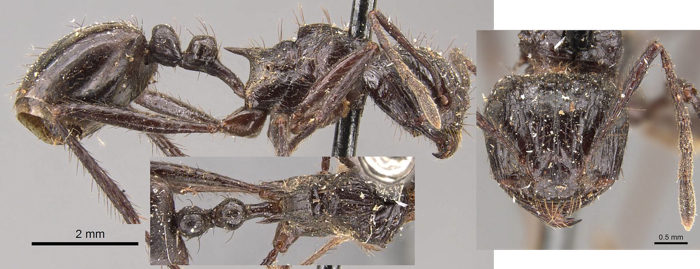 . . |
Great Lakes
area of Central Africa, Mozambique (Sao Thomé?) - striata in part, sensu stricto |
| . | Both nodes of pedicel with a broad profile and the anterior face of the postpetiole near vertical | 22 |
| 22 | Propodeum
profile with sharp rise from metanotal groove and a transverse ridge or
sill; TL 7.7-9.5 mm; occipitum and face densely reticulate; dark
red-brown, gaster dark brown, smooth and shiny |
22A |
| -- | Dorsum of propodeum flat, raised behind the metanotal groove but without a transverse ridge or sill; TL 5.5-7.0 mm | 23 |
| 22A |  Propodeum
profile with sharp rise from metanotal groove and a transverse ridge or
sill; prodeum dorsum weakly concave and longitudinally striate; head
wider than long; TL 7.7-9.5 mm; occipitum and face densely reticulate;
dark
red-brown, gaster dark brown, smooth and shiny Propodeum
profile with sharp rise from metanotal groove and a transverse ridge or
sill; prodeum dorsum weakly concave and longitudinally striate; head
wider than long; TL 7.7-9.5 mm; occipitum and face densely reticulate;
dark
red-brown, gaster dark brown, smooth and shiny |
.. |
| . |  |
Angola &
Cameroun - baumi |
| -- |  Dorsum of propodeum concave and smooth; head longer than
wide, pedicel nodes weakly striate; TL 5.5-7.0 mm Dorsum of propodeum concave and smooth; head longer than
wide, pedicel nodes weakly striate; TL 5.5-7.0 mm |
Ivory Coast east to Cameroun - occidentalis |
| 23 | 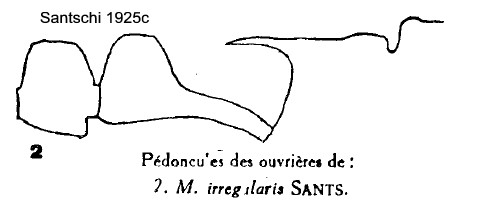 Dorsum of propodeum smooth; gaster hardly sculpted
anteriorly, often darker; TL 5.5-7 mm; bright ferruginous, antennae and
legs, sometimes gaster, much darker Dorsum of propodeum smooth; gaster hardly sculpted
anteriorly, often darker; TL 5.5-7 mm; bright ferruginous, antennae and
legs, sometimes gaster, much darker |
. |
| . | 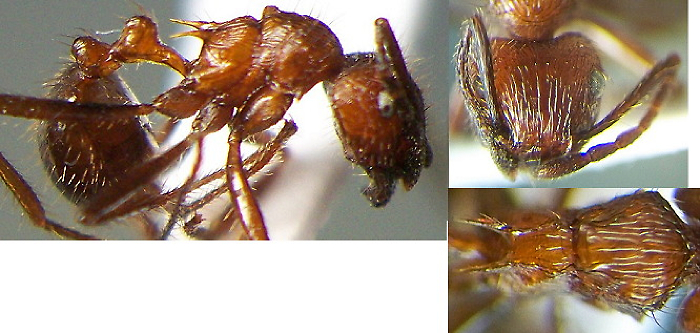 |
Zaïre - irregularis |
| -- |  Dorsum of propodeum
longitudinally rugose; gaster largely matt; red-brown; gaster always
dull; TL 5.5-7.7 mm Dorsum of propodeum
longitudinally rugose; gaster largely matt; red-brown; gaster always
dull; TL 5.5-7.7 mm |
Whole of western Africa - congolensis
with j.syn. crucheti |
| MYRMICINAE Introduction |
© 2007, 2008, 2009, 2013, 2014 - Brian Taylor CBiol
FSB FRES 11, Grazingfield, Wilford, Nottingham, NG11 7FN, U.K. |
href="myrmicaria_key2008.htm"